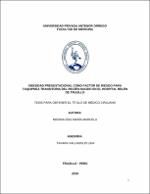Obesidad pregestacional como factor de riesgo para taquipnea transitoria del recién nacido en el Hospital Belén de Trujillo

Ver/
Descargar
(application/pdf: 303.7Kb)
(application/pdf: 303.7Kb)
Fecha
2019Autor(es)
Medina Díaz, María Marcela
Metadatos
Mostrar el registro completo del ítemResumen
OBJETIVO: Establecer si la obesidad pre gestacional es un factor de riesgo para la taquipnea transitoria del recién nacido en el hospital Belén de Trujillo.
MATERIAL Y MÉTODOS: Se llevó a cabo un estudio analítico observacional, retrospectivo de casos y controles. La población de estudio estuvo constituida por 113 casos y 226 controles. Se realizó el análisis de las variables obesidad pregestacional, taquipnea transitoria del recién nacido, y variables intervinientes. Se utilizó la prueba estadística Chi cuadrado de independencia para variables cualitativas y como medida de asociación se calculó el Odds Ratio.
RESULTADOS: Se evidenció en el análisis que la proporción de los neonatos con taquipnea transitoria nacidos de madres con obesidad pre-gestacional fue de 24.78 % mientras que los que no tuvieron taquipnea transitoria fueron 17.26%. OR: 1.56 IC 95% [0.91- 2.74]. Se halló en el análisis que las variables con mayor significancia (p < 0.05) fueron ser neonato de sexo masculino (OR: 1.72 IC 95% [1.08 – 2.73]) y haber nacido con edad gestación a término (OR: 0.32 IC 95% [0.14 – 0.72]). También se encontró que el tipo de parto no tuvo significancia estadística (p= 0.084) OR: 1.52 IC 95% [0.95 – 2.43]; pero sí una tendencia numérica.
CONCLUSION: La obesidad pre-gestacional y la taquipnea transitoria del recién nacido no presentan asociación estadística significativa; sin embargo, se evidencio diferencia notable entre la proporción de casos con taquipnea transitoria frente a los controles con el mismo diagnostico OBJECTIVE: Establish if pre-gestational obesity is a risk factor for transient tachypnea of the newborn in Belén hospital - Trujillo.
MATERIAL AND METHODS: The type of study was an observational, retrospective, case and control and analytical. The study population consisted of 113 cases and 226 controls. The variables analysed were pre-gestational obesity, transient tachypnea of the newborn and intervening variables. The Chi square statistical test was used for qualitative variables analysis and, as a measure of association, the Odds Ratio was calculated.
RESULTS: The analysis evidenced that the proportion of newborns with transient tachypnea born from mothers with pre-gestational obesity was 24.78% while those who did not have transient tachypnea were 17.26%. OR:1.56 IC 95% CI [0.91- 2.74]. It was found in the analysis that the variables with the greatest significance (p <0.05) were being male neonate (OR: 1.72 IC 95% [1.08 - 2.73]) and being born with full-term gestation (OR: 0.32 CI 95% [0.14 - 0.72]). It was also found that the type of delivery had no statistical significance (p = 0.084) OR: 1.52 CI 95% [0.95 - 2.43]; but a numerical trend.
CONCLUSIONS: Pre-gestational obesity and transient tachypnea of the newborn did not have a significant statistical association, however, the evidence is remarkable in the proportion of cases with transient tachypnea versus controls with the same diagnosis
Palabras clave
Colecciones
- Medicina Humana [2969]

